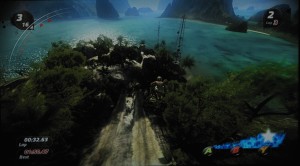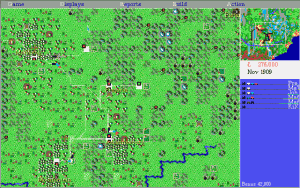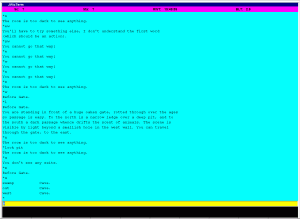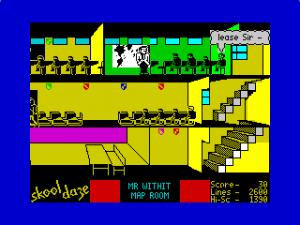215th played so far
 Genre: Racing
Genre: Racing
Platform: Xbox 360, Playstation 3, PC
Year of Release: 2008
Developer: Black Rock Studio
Publisher: Disney Interactive Studios
I am conflicted. On one hand I love Disney. They have provided me with a bucketful of childhood memories from their films and theme parks. I will hold my hands up and say that I have a Donald in a wizard hat sitting on my desk. On the other hand Disney do things like acquire a studio that makes acclaimed racing computer games only to shut them down five years later. I get that there were business reasons, that they wanted to focus on other content… but since when did Disney make off-road racing games? Like never! It’s a move that puzzles and annoys me even more after playing Pure.
Our Thoughts
Cards on the table; I love Pure. It’s a game that I have been itching to play for a long time, ever since watching a demo of it for the PS3, because it looked like a lot of fun. I was pretty much hooked on this game the moment I played it since it reminded me of one of my favourite games of all time; SSX Tricky. This is a comparison I made before reading exactly the same in the book (pipped me to the post again book!) and in many way Pure really is its spiritual sequel. SSX 3 was too realistic and the SSX reboot just… well it never set the world alight. Then there is Pure an off-road, all-terrain racing video game that marries realistic all-terrain racing and the crazy world of cartoon physics. It’s actually interesting here that while there are cartoonish elements to the game, most of it is fairly realistic. The physics are fairly normal and the environment are actually quite realistic. It (mostly) doesn’t share the cartoonishness and implausible environments SSX Tricky brings to the table.
Before we get to the world of the crazy jumping some due care and attention needs to be paid to the graphics because they are simply beautiful. It’s really hard to appreciate the wow-factor of the graphics when you are racing because you are just so desperate to not fall off of your ATV (all-terrain vehicle). The intro video talks about them searching for the most breathtaking locations and by gum were they not playing around. They were great for 2008 and just have so many layers in terms of the backgrounds to the point where during jumps you really can see for miles and miles. Not all are as picturesque as the Italian and Thai courses (with one taking place at a mill in the US desert) but the care and attention that was made… well I just envy those ATV drivers since I would love to be hiking around there.
Another way they have been able to cleverly marry the gameplay with the graphics is how they used the mud. Hands up, I have no idea about mud physics apart from the fact that Minecraft is as unrealistic as you can get. On this though you have to praise them for making the amount of mud and the patterns it makes on your clothes dependent on the course you are racing on, the way that you are racing and how you have constructed your AGV. Just as worthy noting here are the tracks you leave on the ground as you race around and how the game doesn’t shy away from using the mud – it really makes you feel like you’re driving around an improvised track normally only used by hikers.
One way that this game has been able to improve on SSX Tricky is by the inclusion of an amazingly detailed vehicle customisation reminiscent of the Gran Turismo franchise. You get to build your vehicle from the ground up including frames, spoilers, sprockets and other such mechanical things I have no clue about. The fun in this is that you will begin to amass a vast garage of vehicles so that you are able to customise vehicles to best suit the three modes (racing, sprint and freestyle) so we ended up having specialised racing and trick bikes with the sprint events really being a toss-up between the two bikes with crazy names like the Jerobile and Trick Wasp. Usually vehicle customisation bores me utterly but here, because we are talking about crazy vehicles where you can do handstands on the handlebars, I was riveted.
The great thing about this game is that the idea of doing a handstand on the handlebars becomes rather humdrum after some of the ridiculous tricks worthy of the physics of Roadrunner and Wile. E. Coyote. Just like the trick bar in SSX Tricky (sorry about how much this game is being mentioned… but the links are numerous) you need to do a certain number of unique tricks to fill the ‘boost bar’ where you unlock harder tricks which ends up with your riders uber trick signature move such as playing an air guitar solo whilst standing on the back of this rapidly falling vehicle. It’s nuts but it’s the good kind of nuts… like cashew rather than brazil.
With all of this, it’s interesting how this game is still as ‘pick up and go’ as it is. While not as straightforward as the Mario Kart series, the tutorial for the game consists of four actions, with the remainder of the controls explained as you play along. The former is simple – accelerate and break, steer and tricks. A few more elements are added on – a few race types and more special tricks – but none of these are complicated or even vital to know. It’s very close to turn up and go, almost like Burnout 2‘s crash mode – jump in, see what happens and enjoy it. Because it’s so forgiving, it doesn’t feel like much of a penalty to try again, and as it’s an easy learning curve, you can improve rapidly enough to move forward. It doesn’t (initially) demand perfection, just good play, and that makes it a better experience.
Final Thoughts
I doubt there’s many people who realise there’s such a thing as ATV racing, but what this showed is that it’s not only out there, it’s a far more interesting thing than it looks. Closer to BMX than normal road cycling, Pure makes for a compelling and beautiful game. While it has a surprising amount of depth – with so many ways to play the game, I still wonder what the best balance between racing and tricks is – it’s easy to pick up and something you can quickly get into. The way you want racing games – and so many others, really – to be.








